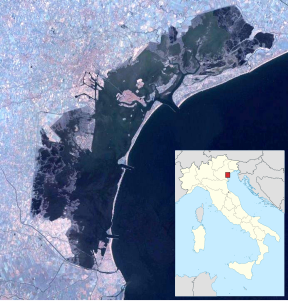Lazzaretto Nuovo
| Lazaretto nuovo | ||
|---|---|---|
| Waters | Venice lagoon | |
| Geographical location | 45 ° 27 '24 " N , 12 ° 23' 8" E | |
|
|
||
| surface | 8.72 hectares | |
Lazaretto Nuovo is an island in the Venetian lagoon , about 3 km northeast of the historical center, opposite S. Erasmo .
The oldest traces of settlement point to the Bronze Age.
In the High Middle Ages, in the first document that mentions the island in 1015, it is still called Vigna Murada , and some hermits lived there. In the 12th century the island was owned by the monks of San Giorgio Maggiore , who built a small church there and consecrated it to San Bartolomeo (St. Bartholomew ). In 1468 a hospital was set up on the island by decision of the Senate. This had the task of preventing infectious diseases. The island, which was now called Lazzaretto Vecchio (old), and which lies in the southern lagoon, took on the suspected plague cases.
For this purpose, hospitals were built on the 'new military hospital', including the Teson Grande , the largest building on the island , in the 16th century . The buildings were the largest public buildings in Venice , along with the rope workshops in the Arsenal . The Teson Grande is more than 100 meters long. To distinguish this “Lazzarett” from the one that already existed near the Lido, it was called Lazaretto Novo , as the entire island was soon called. Sansovino names 100 rooms on the island, which from a distance resembled a castello. The more than 100 chimneys in the Venetian style should have given this impression. Numerous inscriptions have been preserved in the building, as well as drawings that recall the presence of the merchants and which, in view of the dying on the island, should also preserve the information about the goods loaded and stored there. Travel descriptions of ships that had come from Cyprus or Constantinople can also be found there.
During the plague epidemic of 1576, the island became a forced residence for people who might be infected with the disease. Records from this period tell of nearly ten thousand people on Lazzaretto nuovo, and the waterways were clogged by hundreds of ships and boats. After the plague subsided, the island was gradually abandoned by the remaining inhabitants. Around 1700 the island lost its importance as a quarantine location.
It was not until the 19th century that residential and warehouse buildings were created for military purposes. A remnant of fortifications (fortificazioni lagunari) testify to the military conflicts over the lagoon since Napoleon and under the Austrians. Therefore the large arcades of the Teson were walled up, a powder magazine was built there. The walls were equipped with loopholes, watchtowers, bastions made of Istrian marble and earth walls. The island was now connected to S. Erasmo by its own bridge, the Testa di Ponte . A similar connection was made with the battery of the Torre Massimiliano , a tower that guarded the entrance to the port of Lido. Until 1975 the island was used by the Italian military.
In the meantime, the island has undergone extensive renovation under the direction of the Ministero per i Beni e le Attività Culturali . The execution was incumbent on the Sopraintendenza per i Beni Ambientali e Architettonici and the Magistrato alle Acque . For several years now, the island has been subordinate to the Ekos Club, a voluntary association behind a project called 'For the rebirth of an island'. This promotes scientific and cultural activities and coordinates the cooperation between bodies and institutions. The island belongs to the Sistema Bibliotecario Museale, the association of museum libraries of the province of Venice, as well as the Itinerai Educativi , which maintain educational trails .
The result was a circular route about one kilometer long that offers views of the lagoon but also introduces the island's ecosystem. There are laurel trees , ash trees , hawthorns , wild thorn bushes and large amounts of reed grasses. The north side shows typical plant communities deer Barene , as they are common in the lagoon, including Limonium (sea lavender), Salicornia and Artemisia (mugwort). Fish and crustaceans typical of the lagoon can also be observed here. Within the Austrian fortifications, there are several centuries-old mulberry trees , but also ash and poplar trees, plus overgrown fruit trees. In addition to gulls and egrets, there are gray herons , cormorants , a few pairs of kingfisher , falcons and other birds of prey. There are also stilt walkers , referred to here as Cavalieri d'Italia .
Archaeological summer camps are held on the island, introducing excavation techniques and conservation methods, but also source reading and conservation techniques. Underwater archeology and experimental archeology also play an essential role.
literature
- Giordano Trovabene, Alessandro Asta, Marco Bortoletto, Gerolamo Fazzini: Venezia, Isola del Lazzaretto Nuovo. Lo scavo del Priorato , in: NAVe - Note di Archeologia del Veneto, 1/2012, Florence 2014, pp. 76–79.
- Matteo Borrini, Fulvio Bartoli, Alessandra Bacci, Francesco Mallegni: Analisi paleonutrizionale su alcuni campioni dalla mass grave dell'Isola del Lazzaretto Nuovo (Venezia) , in: Archivio per l'Antropologia e la Etnologia CXL (2010) 1-11.
- Francesca Malagnini: Le scritture parietali cinque-secentesche del Lazzaretto Nuovo di Venezia. Appunti linguistici , in: Cuadernos de filología italiana 24 (2017) 11–72.
Web links
Remarks
- ↑ If you take public transport to the island of S. Erasmo, you will see “S. Erasmo Capannone ”, formerly known as“ Baracca ”, a jetty and an elongated building complex.
- ↑ Lazzaretto Nuovo: inaugurato "Il sentiero delle barene" , in: Venezia Today, April 7, 2019.
- ↑ Lazzaretto Nuovo: la Giunta autorizza il prosieguo della campagna di scavi all'Archeoclub , in: Il Nuovo Terraglio, May 19, 20198.

